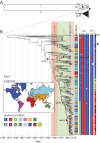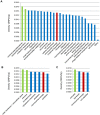Global population structure and evolution of Bordetella pertussis and their relationship with vaccination
- PMID: 24757216
- PMCID: PMC3994516
- DOI: 10.1128/mBio.01074-14
Global population structure and evolution of Bordetella pertussis and their relationship with vaccination
Abstract
Bordetella pertussis causes pertussis, a respiratory disease that is most severe for infants. Vaccination was introduced in the 1950s, and in recent years, a resurgence of disease was observed worldwide, with significant mortality in infants. Possible causes for this include the switch from whole-cell vaccines (WCVs) to less effective acellular vaccines (ACVs), waning immunity, and pathogen adaptation. Pathogen adaptation is suggested by antigenic divergence between vaccine strains and circulating strains and by the emergence of strains with increased pertussis toxin production. We applied comparative genomics to a worldwide collection of 343 B. pertussis strains isolated between 1920 and 2010. The global phylogeny showed two deep branches; the largest of these contained 98% of all strains, and its expansion correlated temporally with the first descriptions of pertussis outbreaks in Europe in the 16th century. We found little evidence of recent geographical clustering of the strains within this lineage, suggesting rapid strain flow between countries. We observed that changes in genes encoding proteins implicated in protective immunity that are included in ACVs occurred after the introduction of WCVs but before the switch to ACVs. Furthermore, our analyses consistently suggested that virulence-associated genes and genes coding for surface-exposed proteins were involved in adaptation. However, many of the putative adaptive loci identified have a physiological role, and further studies of these loci may reveal less obvious ways in which B. pertussis and the host interact. This work provides insight into ways in which pathogens may adapt to vaccination and suggests ways to improve pertussis vaccines. IMPORTANCE Whooping cough is mainly caused by Bordetella pertussis, and current vaccines are targeted against this organism. Recently, there have been increasing outbreaks of whooping cough, even where vaccine coverage is high. Analysis of the genomes of 343 B. pertussis isolates from around the world over the last 100 years suggests that the organism has emerged within the last 500 years, consistent with historical records. We show that global transmission of new strains is very rapid and that the worldwide population of B. pertussis is evolving in response to vaccine introduction, potentially enabling vaccine escape.
Figures



References
-
- Black RE, Cousens S, Johnson HL, Lawn JE, Rudan I, Bassani DG, Jha P, Campbell H, Walker CF, Cibulskis R, Eisele T, Liu L, Mathers C, Child Health Epidemiology Reference Group of WHO and UNICEF 2010. Global, regional, and national causes of child mortality in 2008: a systematic analysis. Lancet 375:1969–1987. 10.1016/S0140-6736(10)60549-1 - DOI - PubMed
-
- Still GF. 1965. The history of paediatrics. Oxford University Press, London, United Kingdom
-
- Lapin JH. 1943. Whooping cough. Charles C. Thomas Publisher Ltd., Springfield, IL
-
- Magner LN. 1993. Diseases of the premodern period in Korea, p 392–400 In Kiple KF, The Cambridge world history of human disease. Cambridge University Press, Cambridge, United Kingdom
Publication types
MeSH terms
Substances
Grants and funding
LinkOut - more resources
Full Text Sources
Other Literature Sources
Medical

